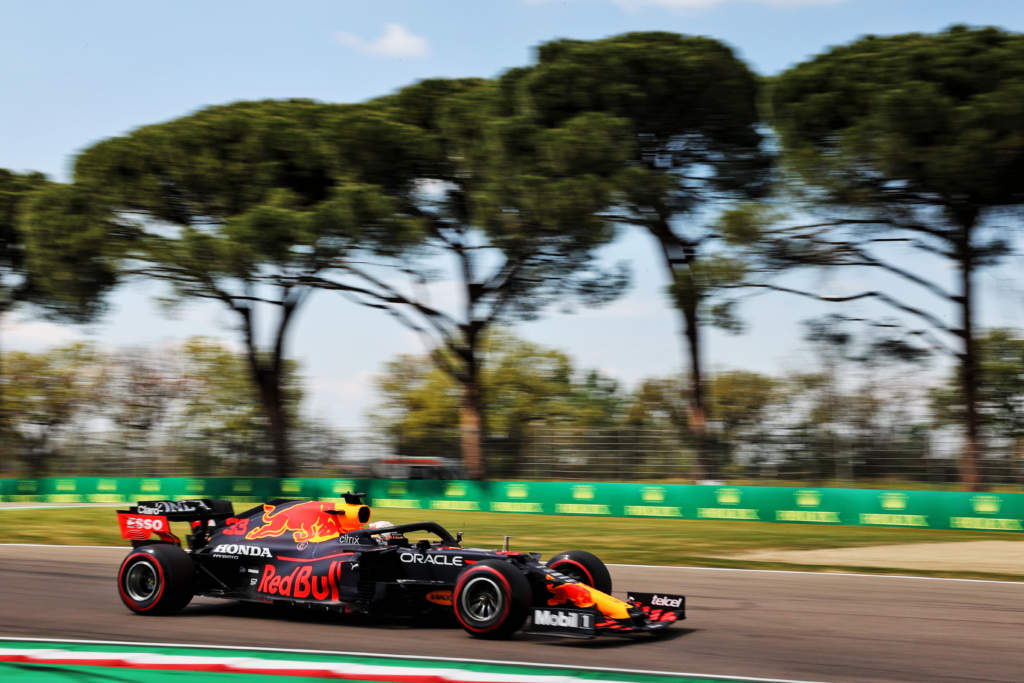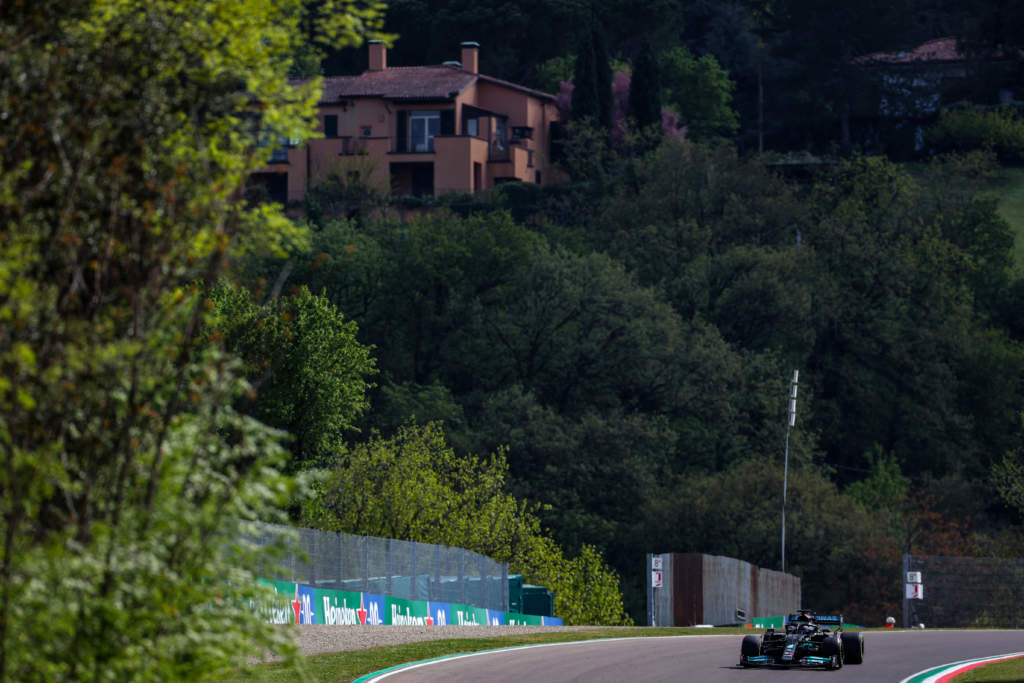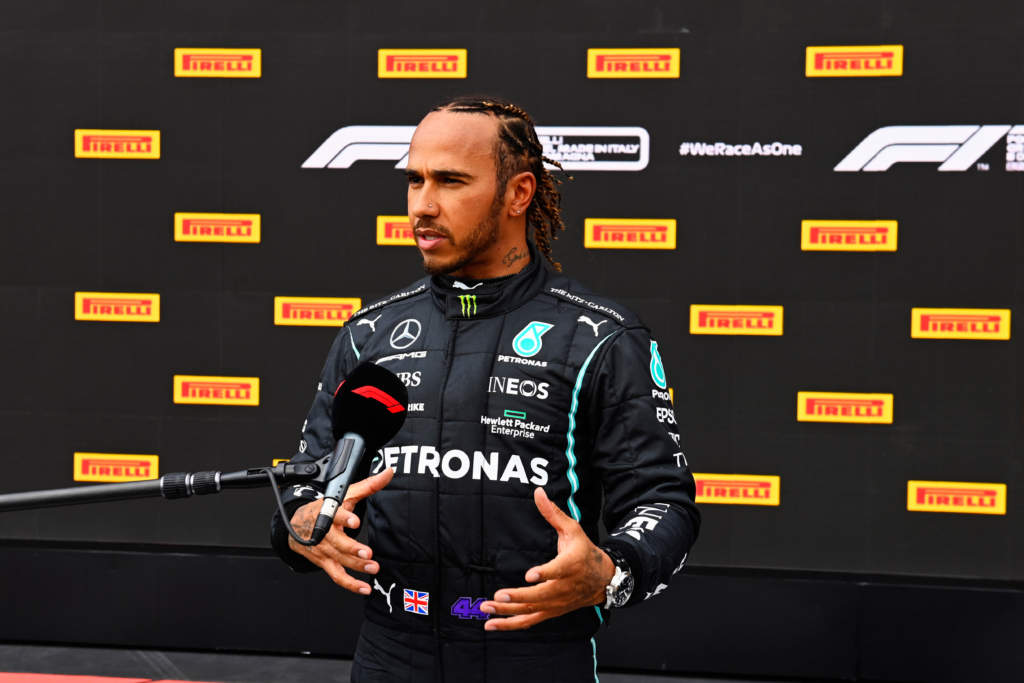Up Next

An incredibly close contest for pole between Mercedes and Red Bull at Imola is great news for the 2021 Formula 1 championship, confirming the Bahrain suggestion that we have a genuine battle on our hands between the two best teams and two best drivers in F1.
In Bahrain Max Verstappen’s margin of superiority in qualifying was exaggerated by a mistake from Lewis Hamilton under braking for Turn 10 – the Mercedes’ weakest part of the circuit, where its front end just could not withstand the combined lateral and braking load imposed there and would repeatedly lock a front wheel.
Around Imola on Saturday it was the Red Bull which was the more challenging drive, more alert and responsive than the Mercedes but demanding more input from the driver on the entry phase of the corner.

Hamilton took pole with a lap that was as close to perfection as Verstappen’s had been in Bahrain, but both Red Bull drivers made pole-costing errors on their final runs – Verstappen’s at Turn 3 where he had two wheels on the dirt as he exited Tamburello, then another in the final sector. Sergio Perez lost crucial time at the final turn where he dipped a right-rear wheel just a little too far beyond the kerb.
“We can see that if you put Verstappen’s ideal lap together he would have been on a comfortable pole,” accepted Mercedes’ Toto Wolff.
“Lewis’s lap today was very good. We’ve worked hard to sort out the balance issues we had in Bahrain. The driveability of the power unit got better, track conditions were very different. They all played a part.
“But compare Max’s lap without the mistake and Max would have been solidly on pole – maybe not as much as in Bahrain but still there. All those things combined are what gave us pole today.”
Verstappen missed pole by 0.087s but his combined errors cost 0.186s to his theoretical best. Perez lost out on pole by just 0.035s: more than his last turn error cost him.
Make the ideal sector combination for all of the top three and they would line up as:
1. Verstappen 1m14.312s
2. Hamilton 1m14.328s
3. Perez 1m14.357s
Just a slightly different set of demands has decided things in favour of one team rather than the other, lending hope of a perfectly poised battle for the season to come.
Around the high-speed sweeps of Imola, on a cooler and grippier track surface than Bahrain, the Mercedes needed to be very finely-tuned within a tiny window of set-up to keep it from understeering excessively, but once in that window it worked very well.

The Red Bull too had a narrow window here, notably more so than in Bahrain. It retains superb agility on corner entry but around the super high-speed sweeps of this place and on a track surface considerably grippier than Bahrain’s, that brought with it a somewhat more nervy car in which it was easier to make errors.
The high-rake concept and the enhanced way it moves the aero balance forwards as the car slows for a corner is for sure contributing to the Red Bull’s more responsive behaviour. But this is seen to best effect into slow corners, of which there are very few around Imola. Into fast corners, it can be a challenge.
The key to a good lap around here isn’t so much virtuosity as inch-perfect consistency and momentum. That’s easier to do if the car isn’t aggressively pointing into the turn, eager to get to the next one but demanding the driver keep up with the consequences.
A car with a slight tendency towards understeer – ie the Mercedes since its set-up has been refined to keep it away from the wayward rear end it suffered in Bahrain testing – is always going to be an easier drive around here.
“Here we were very rarely over the temperature [threshold] of the tyres, unlike in Bahrain,” explained Hamilton, “and that’s brought us more into line with the Red Bulls.
“We’ve just been really focusing on refining the balance – there’s a really narrow window of the tyres working at their best. So our car is on more of a [set-up] knife edge than previous years.”

In the long runs of Friday both Hamilton and Valtteri Bottas came in after two laps of their long runs to get a balance change before continuing on. Into qualifying and the balance change between the medium tyres used in Q2 and the softs in Q3 would have lessened the Mercedes’ understeer. On Verstappen’s Red Bull, the same change would have made its latent oversteer easier to trigger.
Significantly Perez did both his Q2 laps on the soft and so would have got more of a feel for it than Verstappen’s part-lap on that tyre after setting his time on the medium. Would that have made a difference? Who knows, but such are the tiny margins we’re talking of, it may have.
Where was Bottas, who had dominated the single lap times on Friday (albeit when both Red Bulls were in the wars)? With the balance change made since those long runs, he needed two laps to bring the front tyres in. It was a luxury that couldn’t be afforded in Q3 if you still wanted to get two new-tyre runs.

Hence both times his front tyres were drastically under-temperature in the first two big corners of the lap. He was as quick as Hamilton sectors 2 and 3 but a disastrous 0.3s adrift of him in the first sector, this just emphasising how lap time here isn’t so much virtuosity as technically-driven.
“The speeds and accuracy you need around here are extreme,” said Hamilton, “You saw Lando [Norris], just a couple of inches and you’re over track limits.
“But you really need to use every inch of the road here and the speed we’re travelling through the first couple of corners, all medium and high speed – it’s phenomenal.”
The car really needs to be cooperating, even more than usual. There’s not much improvisation to be done, just precision, commitment and concentration.

Asked how this lap compared to his virtuoso pole lap of Singapore 2018, Hamilton replied: “It’s a very different vibe. But it was a really clean session. Time and again, just tweaking and adjusting. I was gunning for pole, of course, but it was the tidiest lap I could put together.”
Just underlining the very different challenges from situation to situation, track to track, car to car. So making direct comparison between the quality of a driver’s lap at this level impossible.
It was much more about accessing that narrow window – of both cars – and then putting the perfect lap together within that window. The traits of the potentially faster Red Bull made that more challenging than those of the Mercedes. But getting the Mercedes into that window was a feat in itself.
“In this morning’s practice they were six tenths faster than us,” Hamilton added. “There’s no way I could make that difference up. But we just kept our heads down and the team did a fantastic job in finding that place.”
The narrowness of the Mercedes’ window was only underlined by Bottas’ tyre warm-up problem. But the 2021 closeness of competition between the two top teams has vastly amplified how costly such a problem will be.
Last year, in a Mercedes with a qualifying advantage that averaged out at 0.7s such a problem would still have had Bottas starting on the front row. This year – and especially at Imola where the McLaren, Ferrari and AlphaTauri were closer to the ultimate pace – it left him looking silly in eighth. But silly only if you judged at a surface level.
A breath of wind, a bit of cloud cover, a different track surface this year can completely change the whole picture. It may well change again during the race. This is looking set to be a humdinger of a season.






